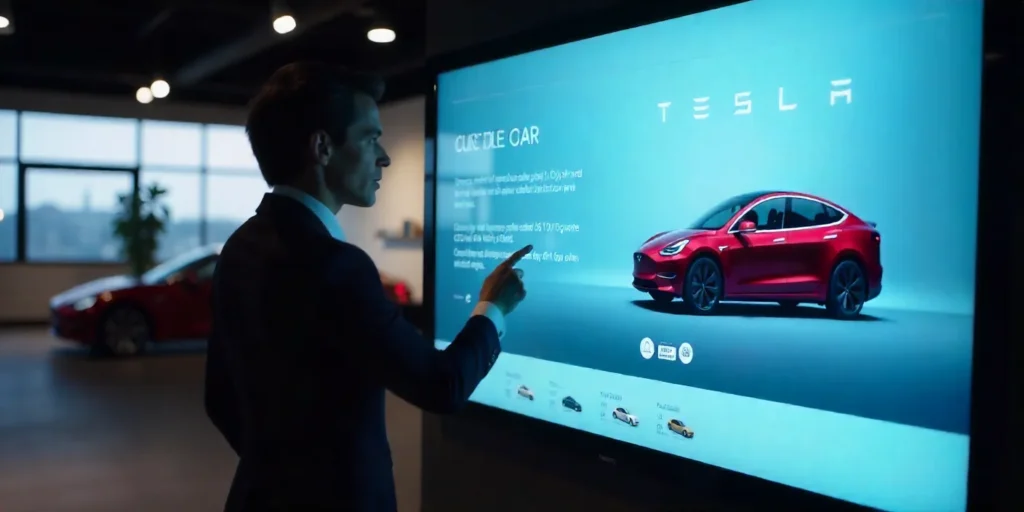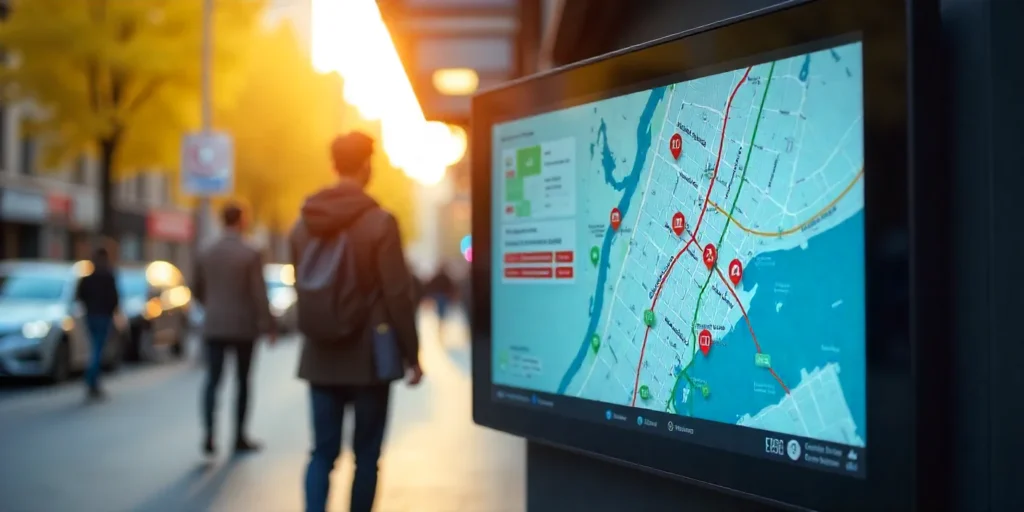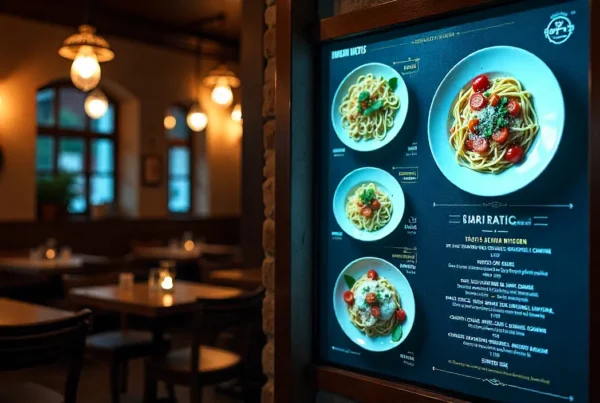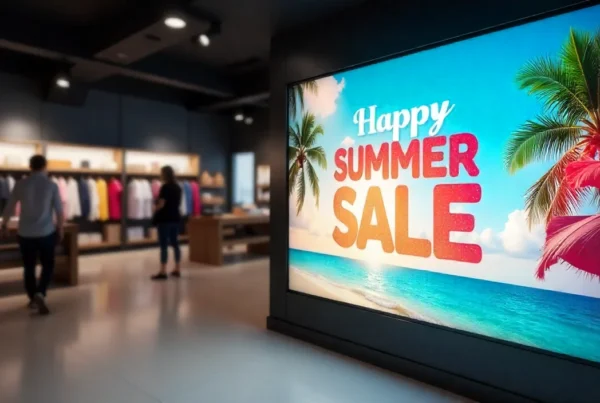Customers are no longer satisfied with waiting to receive information—they want to tap, swipe, and go. Interactive touchscreen solutions transform passive screens into two-way assistants who direct visitors, take orders, answer questions, and track what works. Whatever you are implementing—a lobby directory, a museum table, or a self-service menu—the right combination of touch screen display hardware, software, and experience design will make every second on screen feel seamless.

What Are Interactive Touchscreen Solutions?
The touch screen interactive solutions consist of a commercial panel (tablet kiosks, wall-mounted big touch screen monitor), a player/PC, and touch screen software that interprets touches and gestures. Combined, they provide practical interactive display technology for real-world tasks—digital wayfinding signage, on-screen product finders, and ordering.
Hardware: Designed to be in the open
Commercial panels (including a high-bright touch screen TV monitor for windows) are designed to be used in long-hour environments with higher luminance, durable glass, and stable mounting, which consumer televisions cannot match.
Software: Brains, Schedule, Control
Experience applications are built on interactive digital signage software, which schedules, manages devices, and supports role-based publishing. POIs, routing, and accessibility paths are powered by specialized digital signage wayfinding software to provide maps and directions.
Content & Interactive Screen Design
Hierarchy is clear, targets are easily reached with fingers, loops are short, and movement is used minimally to keep interactions quick and error-free. Good interactive screen design finds the user where they are in the kiosk, queue, or gallery.
Where They Shine Across Industries
Retail & QSR
Transform browsing into purchases: aisle locators, endless-aisle catalogs, and a streamlined touch screen ordering system at the point of demand. A tuned touch screen menu ordering system increases add-ons (sides, dips, and desserts) without slowing the queue.
Corporate, Public, and Transport
Digital signage and digital signage boards are used in atriums and concourses to provide interactive signage and events, directories, and alerts. Airports, hospitals, and campuses use wayfinding signage to mitigate confusion and keep people in motion at decision points.

Education, Culture, and Tourism
Interactive displays of business-grade hardware are being used in museums, libraries, and visitor centers to drive zoomable artifacts, timelines, quizzes, and multilingual content—learning by doing, not reading.
Hospitality & Healthcare
Self-check-in, room choice, e-menus, and service requests offload repetitive tasks to the screen so that staff can concentrate on more value-added assistance, and analytics can identify peak requirements by the hour and location.
Design & UX Principles That Make Touch Work
Clarity First
A single purpose per screen and easy options to go back and home. When a person has to ask for help, the design is missed.
Touch Targets That Forgive
Buttons = 44-56 px and with plenty of spacing; labels at least readable at 1-2 meters. Fingers are not cursors; design accordingly.
Performance = Trust
Lag destroys immersion. Compress the media, cache the assets, and keep the transitions tight so that every touch screen display feels immediate.
Accessibility by Default
High contrast, captions, language toggles, and optional audio; compatibility with assistive technology where the OS permits. Accessibility is not optional.

Wayfinding That Actually Helps
Big buildings seem smaller when they are honest and up-to-date in terms of directions. Install digital wayfinding signage at entrances, elevator banks, and intersections; print step-free routes and real-time diversions (e.g., gallery closed, lift out of service). Digital signage wayfinding software eliminates the need to update floor plans, POIs, and routing logic on individual kiosks as well as on handheld mobile devices. That is how wayfinding signage should be: fewer questions, satisfied visitors, and less congestion.
Hardware & Form Factors (Pick for the Job)
A high-nit touchscreen television monitor with anti-glare glass avoids washout in bright windows or atriums. In a teamwork scenario and in classrooms, install a large touch screen monitor (55 or 86 inches) with multi-touch to allow multiple users to interact simultaneously. Narrow portrait kiosks are preferred in tight foyers; outdoor installs require enclosures, thermal management, and ambient-light sensors. Regardless of the format, commercial-grade touch screen displays and secure mounting and cable routing preserve uptime and appearance.
Ordering & Menus That Sell (Without Feeling Pushy)
Frictionless Flow
Category (item) modifiers (pay). Ensure thumbs are kept in a single area and restrict scrolling—an average order should take no more than a minute on your touchscreen ordering system.
Intelligent, Situational Upsells
Instead of nagging, use rules in your touchscreen menu ordering system to promote profitable add-ons (sides with mains, hot drinks on rainy days, and family bundles before big games) without nagging.
Live Accuracy
Refresh prices and availability to POS/inventory so when items are sold out, they automatically hide, and promos tick over at the correct time. Fewer apologies, quicker queues.
Software Buying Checklist (Avoid Regret Later)
Management & Scale
Interactive digital signage software with the capability of remotely updating device health, proof-of-play, and role-based publishing. Brand kits and templates keep dozens of sites in sync.
Integrations
POS/CRM/inventory retail/QSR; calendars/room systems corporate; mapping data/sensors digital wayfinding signage. Your platform should speak to you using the data you trust.
Security & Governance
Kiosk lockdown, session resets, SSO, audit logs, and encrypted transport are all table stakes. Governance causes interactive displays to become business-on-brand and compliant.
Analytics That Matter
Event logs and funnels show what is actually touched, information that can be used to optimize position, copy, and media weight across the digital signage boards network.
Launch Plan: Pilot to Scale
Start with a single high-impact area and precise KPIs (find, order, check-in, learn). The prototype is run on actual hardware in actual lighting. Run a 2-4 week pilot, and monitor completions, dwell, and drop-offs. Standardize templates, mounts, ADA sightlines, and scale in waves with staff training and monthly iteration. This is how interactive touchscreen solutions are useful—not just novel.
Turn Foot Traffic into Interaction
Bring your floor plan, must-solve journeys, and timeline. We will design interactive touchscreen systems per zone, i.e., lobby touchscreen digital signage boards, campus touchscreen digital wayfinding signage, retail touchscreen digital signage, and QSR flows through the touchscreen ordering system to pick up, supported with the appropriate hardware, touchscreen software, and governance so that you can go live quickly and expand cleanly.
FAQs: Interactive Touchscreen Solutions
What’s the difference between standard and interactive digital signage?
Standard is a one-way broadcast. Interactive digital signage encourages tapping and swiping to view catalogs, find directions, or accomplish tasks, turning attention into action.
Can I start with a consumer TV?
Commercial hardware is required, perhaps, in the case of pilots. A touch screen TV monitor with a long hours rating, brighter display, and warranty will be cost-effective in the long run.
Do we need specialized mapping tools?
Yes. Wayfinding software converts the floor plans, POIs, accessible routes, and detours and publishes consistent directions to kiosks and mobile devices.
Will it integrate with our systems?
Modern systems integrate with POS/CRM/inventory and calendars using APIs/webhooks, maintaining interactive displays for businesses that are accurate across locations.
How do we keep UX consistent across locations?
Set up brand kits and templates in your CMS; only allow local edits to hours, promos, and events. That keeps interactive digital signage scalable and on-brand.
What about giant collaboration surfaces?
Select multi-touch controls on a big touch screen monitor so two or more people can sketch, resize, and sort without ghost touches—perfect for planning walls and classrooms.





